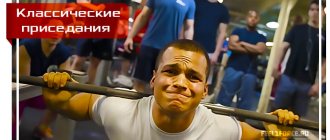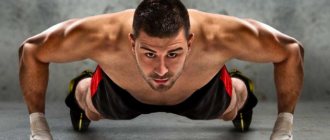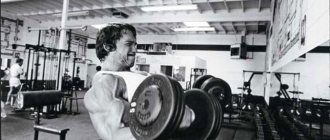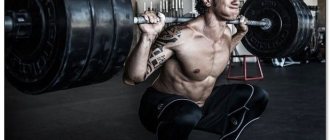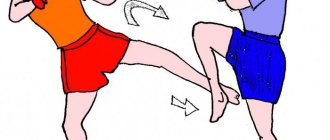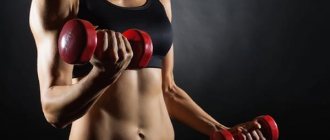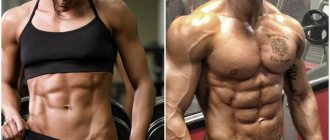Hello dear friends of the boxing blog! Let's break down the topic now; how to punch your fists at home. Not all people have the opportunity to go to the gym and train on special machines. You can use available tools and work at home. Before stuffing, it is necessary to strengthen the muscles and ligaments with special physical exercises. They will help us:
- Push ups.
- Dumbbells.
- Weight.
These exercises will prepare the muscles and ligaments for shock loads. If you do not follow them, there is a high probability of injuring your limbs.
Push ups
For this we need free space and floor. Perform push-ups not only on your fists, but also on your fingers and wrists. In addition to muscles and ligaments, the joint capsule begins to strengthen. It is she who bears the brunt of the blow. After half a year of regular push-ups, calluses will begin to appear on the skin, nerve endings will begin to die, and after striking a hard object, the limbs will become less sensitive to pain.
Accuracy
Accuracy is a very important component of a knockout blow. It is achieved through regular training and correctly applied knowledge. Why is it so important? Let's take water for comparison. If you were doused with a bucket of water from head to toe, you would simply not be pleased, right? What if all the water in the bucket was collected at one point and directed at you under pressure? At best it will leave a bruise, at worst it will throw you to the ground.
We have the same principle. If the blow is smeared, then it will only make it unpleasant. But if all the strength and speed that we have learned to develop are collected at one point, then you will deliver a fairly significant blow. To practice the accuracy of your strike, you need to know: how to properly shape your hand, which part of your fist to hit, how to fill the back of your fist.
Knowing how to form your fist correctly will protect you from injury and add extra power to your punch. Unfortunately, most people do not know how to make a fist correctly. This is due to various factors. Boxing uses bandages and large gloves that allow you to forget about proper formation. In a real fight, without gloves, this will have a detrimental effect on the boxer’s hands.
How to clench your hand into a fist correctly? Let me teach you. Extend your open palm in front of you and begin to twist it in the following sequence: first the phalanges, then the knuckles, and then press your fingers into your hand so that your fist forms an angle of 90 degrees, folded?
Now this entire structure needs to be secured with your thumb. But in reality this is not enough. You need to constantly do push-ups in this position. During push-ups, all the weight should fall on the two front knuckles of the hand. By the way, they are an ideal striking surface for a fist.
Dumbbells
The most common exercises at home are exercises with dumbbells. During the first lessons you should not lift heavy weights. It is enough to put 2 kg in each palm and make various movements with them; lift up and down, make flexion and extension movements in the elbow joint, keep them static, opposite your head, rotate your hands in different directions. Such general strengthening actions will perfectly prepare your knuckles for padding. You can also work with heavy weights; take dumbbells in your palms, place your forearm on the table so that your hand hangs slightly, bending your wrist, lift them up and down until you feel tired.
Hardening of the striking parts of the arms and legs. Shaolin and Okinawa Te martial arts
(Click on the link above for details) It is also necessary to make a reservation regarding the fundamental differences in the methods of limb hardening in the Shaolin and Okinawan traditions. Either the ancient Chinese teaching was transmitted or not accepted in its entirety, or for some other reason, only the islanders to this day are able to achieve their goal directly - by delivering tens of thousands of blows to tree trunks, boards, stones and special makiwaras. However, Shaolin martial arts took a more intelligent and wise approach, following through the hard "external" qigong. It was considered strict and categorical that the transition to the full-fledged practice of actually hitting hands and feet on solid objects was allowed only when “Qi began to ooze through the pores of the skin.” Simply put, the development of crude striking techniques was delayed in relation to the practice of mastering the small and large “heavenly” orbits of energy circulation in the body. This was the only way to avoid immediate injuries and harmful long-term consequences for overall health. There were also special secret recipes for multi-component balms and rubs, made according to all the canons of bottomless medical wisdom and aimed at eliminating inevitable energy blocks and “traffic jams”, and the general harmonization of the flow of Qi.
Today, when passions have subsided and the fashion for oriental martial arts has firmly entered its normal natural course, you will no longer see red-haired young men on the streets with terrible white “hooves” on the knuckles of the index and middle fingers. But twenty years ago, when I first touched upon the exotic world of karate, the intensity of enthusiasm was incredibly high, and we all tirelessly hammered our fists into various homemade devices, immersed our hands in hot sand and strong brine in order to give them the legendary all-crushing strength. Fortunately, I never crossed some reasonable boundaries in these amusements, and now, looking back at the path I have traveled through the prism of my own and other people’s experience, I can only sincerely feel sorry for the adherents of the “steel” fists, whose insane zeal laid a solid foundation for many bone and joint diseases , these guys have never thought about how to properly and painlessly fill their arms. Kach was also unique, simple and functional; beauty was the last thing they thought about. There was no way they could order creatine at that time; there was simply nowhere to buy it. Yes, and the food on Okinwa was not that great. So we are the lucky ones in our technological age...
It is not difficult to understand that the ancient Okinawans were forced to such practices by the harsh conditions of their existence, and they did all this, presumably, without much pleasure, much less thinking about the vague consequences. The question is how to train your hands . to make it softer, just don’t stand. But today, in a normal modern world, we do not need to break through our armor, and for a reliable guaranteed defeat of an unprotected body, moderate hardening of our natural “weapons” is quite sufficient. Being personally acquainted with many extremely high-level masters (both athletes and “practitioners”), I can testify that not one of them has worn or wears the mentioned “stamps of stupidity” on their fists. Moreover, their hands are completely indistinguishable from hundreds of thousands of others - at least externally. But if someone is eager to succeed in this field, I can give some proven practical advice.
The stuffing shell should not be hard, but only dense, with a soft surface layer. Large, heavy bags of polyethylene granules work best, since peas and beans crumble too quickly and sand turns to stone. Under the outer shock-bearing layer, thin felt should be placed, which will eliminate the most painful “dry” contact of the fist with the filler. You should not make your bag too heavy, as you may get into the habit of working with an almost motionless massive target, while the real enemy is light and evasive, significantly compensating for the power directed at him. But excessively light tackle is even worse; it provokes the development of dashing, high-speed, but initially empty equipment, the maximum achievement of which will be a black eye or a bloody nose. Light bags and pears do not allow you to “position” your wrist, that is, fold it into a single rigid structure. If, after reading the article, it is not entirely clear to you how to improve your skills at home, then I can recommend Mikhail Shilov’s video course , which has no analogues in the world, “Iron Fist,” which is praised by both karatekas, boxers, and thaiboxers, and this says something . After all, a strong fist is a help in any martial arts. And it’s not just the martial arts of Shaolin that need it.
To be continued…
Based on materials from Valery Khorev.
Floor
For padding, the most suitable one is parquet or boards. It is necessary to focus on lying on your fists and alternately hit the surface. Strike not only with the first two knuckles (index, middle fingers), but also with the others (ring, little finger). This is done so that if the target moves or you, in a fit of anger, hit the wrong place where you wanted, the fragile phalanges will be injured. If hitting a hard surface in your first lessons hurts a lot, lay a towel on it.
You can watch how to punch your fists at home in this video:
It is necessary to strike with a third of force. After a year of daily training, the nerve endings on the knuckles will die, the pain threshold will decrease, the bone tissue and joints will become stronger - you can hit harder.
How to properly adapt your hands to strikes?
It is definitely necessary and important to train your strike! But by wearing gloves or other special equipment and practicing punches on a punching bag or bag, a novice boxer will better develop his arm to an optimal level.
Picture 2 - Using gloves or special equipment, the fighter will fill his hand to the optimal level.
By understanding how best to place your hand when throwing a punch and rotating it correctly, a fighter will be able to deliver strong and accurate strikes without gloves. The main thing is practice and knowledge, and not “filling your fist.”
If you watch boxing legends, and indeed just professionals, you will notice that they all always wear equipment, even during training.
Picture 3 – Professional boxers always train in equipment.
Because it is, at the very least, stupid to mutilate your hands on shells, leaving drops of blood.
Wall
Let's look at how to quickly and effectively fill impact surfaces at home using a wall and auxiliary materials. This is the hardest surface and it is recommended to put it under it. If you hit a reinforced concrete surface directly, you can break your arm or damage your joint capsules. Let's take wooden planks and fix them on the wall, at chest level. We don’t hit too hard, about 30%-40% of the maximum. Then, when your skin becomes rough and calluses appear on your knuckles, increase the force of the blow.
There are good exercises when using newspapers. We take a large number of them (approximately 50-70 pieces), fix them on the wall, every day for 5-7 minutes, beat the knuckles on them. After 3-4 days, we discard one newspaper at a time. After performing the discipline for about a year, your hands will become much stronger and will no longer feel severe pain when hitting a bare wall. You can hit any hard surface without worrying about your fist.
So is it necessary to stuff your fist at all?
The answer is yes. But you need to stuff it completely differently than what the “sofa advisors” on the Internet advise.
The fist will be filled to the required level and adapt to blows if you train correctly, protecting your hands with special equipment designed for this.
Picture 4 – To “fill up your hands”, 15 minutes on the bag will be enough.
In fact, for the necessary “stuffing”, 15 minutes spent alone with a pear or bag will be enough. If you really want, you can train with your bare hands. Only you don’t need to hit with full force, but somewhere around 20 percent. By training this way regularly, over time the boxer’s fists become less sensitive, and the athlete can already begin to hit harder.
It is this gradualness that prevents injury to the fist, but, on the contrary, will bring it to the desired level.
Another optimal way to “fill” your fist is with regular but effective push-ups on your knuckles. They will help strengthen the surface of the fists.
Nutrition
A person is not always able to provide his body with the necessary micro and macroelements. With constant physical activity, an appropriate diet is necessary. Sports nutrition will help us with this; use supplements with the following content:
- Collagen.
- Glucosamine sulfate.
- Chondroitin sulfate.
By taking supplements containing these substances, you will perfectly strengthen and restore your joints and ligaments. Diversify your diet with different foods. The more there are, the better for the body.
Types of side punches in boxing
There are two main types of side punches in boxing, namely the swing and the hook. When performing each of them, the serve is made with either hand. The swing is characterized by a large swing, often with a lowered hand. It is applied from a long distance and over a large amplitude, which provides greater impact force. However, you can quickly block him or simply move aside. The hook is shorter and not as sweeping. The force in this case will be less due to the lack of duration of the distance. However, it is an effective and versatile strike that not only helps you get out of many situations, but also gives you the opportunity to launch your own attack.
From a straight position
The mechanics of striking in this position are based on the transfer of body weight. Because of this, the center of gravity is transferred directly from one leg to the other. The body is rotated synchronously directly along the inclined axis. This is followed by a movement of the hand, which quickly strikes in a horizontal plane. Such a blow is a combination of three movements performed simultaneously; it can be delivered both from a place and while moving. In the case when a serve is made with the right hand, then accordingly the body weight should be transferred to the left leg. In this case, the body should be rotated along an inclined axis that passes through the left shoulder, and also the right arm. At this time, the arm bent at ninety degrees at the elbow should make a lightning-fast semicircular movement horizontally. The fist should be in a half-turn towards the athlete with the fingers pointing towards themselves. During this, the left hand protects the head, and at the end of the blow it returns to its original position and prepares for the next action.
Left hook from side position
The left hook from a side position can be thrown in three different ways. In the first case, the blow will be delivered with a step forward; in the second option, with the right foot stepping diagonally to the right; in the third case, the feed is accompanied by a deflection of the body back. The main difference is manifested in the degree of tilt of the boxer's body, as well as in the vector of movement of the striking hand.
Right hook from side position
The hook from this position is accompanied by rotation of the body accordingly along an inclined axis, which passes through the right leg, in particular the toe and left shoulder. Can be used as an attack or counter strike. The strength will be determined by the degree of rotation of the body to the left.
Training of the shoulder girdle, triceps and back
These muscle groups are far from the least important in training striking power.
You can train them with the following exercises:
- You may have heard that push-ups increase punching power. It's true. Take a lying position and place your hands as close to one another as possible. The back remains straight without arching. Bend your arms and straighten them with maximum amplitude. In order to strengthen your hands, you can do push-ups on your palms and fists.
- Pull-ups. When doing pull-ups, your hands hold the bar wider than your shoulders. To increase performance, you can hang a weight on your belt in the form of a strap with a barbell plate attached to it. The number of repetitions should be as much as your physical fitness allows.
- Reverse push-ups. You can perform this type of exercise with a bench. Stand with your back to her, lean your elbows on your palms, and squat down slightly without arching your back. Lower and rise by bending and straightening your arms. For the desired effect, perform 3 sets of 20 times.
- Kettlebell lifts will help strengthen your hands and develop your deltoids. Deltas are of great importance for the development of attacking movements. Above all, this is the equipment that exercises will help you build muscle.
- Kettlebell raises forward. Spread your legs to the sides, and hold the projectile in a straightened hand between your legs. Bend your knee joints slightly. With a sharp movement, lift the weight forward so that a right angle is formed between the body and the projectile. At the same time, make sure that your back remains straight at the top extreme point. Perform 8 repetitions for each arm. When performed correctly, you should feel tension and trembling in the muscles.
- Lifting the weight up. The execution is similar to the previous one, but lift the projectile above your head. We recommend 8 to 12 repetitions for each side.
- Classic kettlebell lift. Place the apparatus between your spread legs. The hand is placed on top of it so that the hips remain slightly behind. A sharp upward jerk is performed, while the weight is thrown onto the shoulders, and then lifted above oneself with a push. Returns to the starting position. Perform 10 lifts on each arm.
- Raises with a kettlebell from a seated position. Throw the weight over your shoulder and squat down. Extend your free hand forward to maintain your balance. Lift the weight above you, wait a second, lift your torso. Change your hand. Make sure your glutes and calves remain tight. Perform 5-10 repetitions on each arm, depending on your physical fitness and weight of the apparatus.
- Working to overcome reverse resistance will help increase the force of your hand strike. Cut a piece of elastic from the tire, or buy a thick elastic band for exercise in the store. Fasten one end tightly to the wall behind your back, and take the other end in your hand. Perform “punching” movements forward, overcoming resistance and stretching the elastic band. Move your arm back gradually to avoid injury.
- Two weights up. Throw both projectiles onto your shoulders. Take a deep breath into your lungs, jerk them above your head, and then slowly lower them. Tighten your abs while doing this.
We hit with our fists
- Firstly, in order to understand how to punch correctly, you need to form it correctly, otherwise you risk seriously damaging your hand, and even breaking your thumb. When forming a fist correctly, the thumb should be on top of the rest. It cannot be hidden inside, otherwise the entire force of the blow will be directed specifically at it, and, most likely, the incident will end in a dislocation or fracture.
- Considering the striking technique directly, it should be noted that it is better not to hit with knuckles. Use the flat surface formed by the first phalanges of tightly closed fingers.
- The most effective blow will be one in which the athlete’s weight is invested, this means that at the moment of moving the fist towards the enemy, the whole body must work, including the arm, shoulder and thigh.
- It is advisable not to fully extend your elbow at the moment of impact. In general, it is better to fix it in the position: the arm is raised parallel to the floor, and the elbow angle is 900. Working with the whole body will make the blow from this position stronger.
For example, a right hand strike from the right side in boxing is carried out as follows. The right leg is tightly fixed on the floor, the main support of the body falls on it, then, along with the movement of the body, energy moves from the legs to the hand, clenched into a regular fist - the body gradually turns, the movement of the lower back and waist turns into the work of the entire torso. It is the boxer’s body that is the main source of energy, the fist is only the means by which this energy is delivered to the opponent.
Video - instructions for placing a strike
Tips from Bodyuk - how to properly prepare your fist
Requirements
When performing a side kick, you should turn your body, while sending your hand in the same way as in the case of a direct serve. The limb extends in a straight line directly along the attacker’s block in the shoulder area. At the moment when the fist has almost reached the enemy’s hand, it is necessary to raise the elbow, making an effort with the shoulder and bypass the block. In this case, it’s the same side hook. However, with such a performance, the arm is not swung, and it is directed towards the shoulder area. It appears that the blow is coming in a straight line, but it is still thrown from the side. Movement in the shoulder is supported by an impulse, which is formed in the following cases:
- when hit by an opponent;
- when turning the pelvis;
- when turning the hip.
When performing punches in boxing, it is important to focus on a large amplitude of the body. There are also some requirements for how the fist should be positioned during a side impact. In the case when the distance is large, the position of the hand should be the same as with a direct feed. This is due to the impossibility of full-fledged work at such distances. In order to correctly perform a left side kick, you need to turn your body. Next, the attack is carried out as if striking with the elbow, but the arm at the elbow will need to be straightened. In order to throw a hook with your fist, you need to correspondingly extend your arm to an angle that will be sufficient to reach the target at the current distance. In this case, it will be necessary for the shoulders to work freely; this is an important requirement for the correct technique. Maximum freedom and mobility of the shoulder joint is of great importance.

